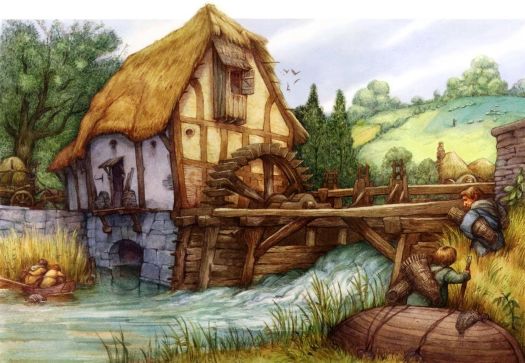Fulling Mill
Fulling mills are large buildings resembling gristmills, designed for the crucial task of completing the cleansing process for carded or combed wool. This involves matting the fibers together to enhance their strength. While much of the fulling process is still carried out manually due to the primitive nature of machinery, fulling mills are present in more advanced hexes, particularly those of type-6 or higher.
Contents
The fulling capacity of a mill typically ranges from 25 to 100 lbs. of spun fiber per day, contingent on the efficiency of the mill. Once the thread is manufactured, it's sacked and prepared for transport to be utilized by weaving guilds.
Inhabitants
Typically overseen by an extended family, the management structure of these mills varies. Rolling 2d6, a result less than 7 would indicate one couple and children managing the mill, while a roll of 8-12 suggests the involvement of two or more related couples and siblings.
Construction
Water power is used to turn a wheel, attached to an axle, which incorporates a cam that allows a massive hammer to pound continuously, producing agitation in wool fibres sitting in water-filled trays under the hammer's blows. The process is also used to clean and whiten woollen cloth.
Another arrangement is employed for the rolling and scutching of pulled cotton or retted flax. This brings these fibres into a state for weaving cotton cloth or linen. Similar milling arrangements are designed for managing other fibres such as jute or hemp, but fulling mills for these fibres are rare.
Minimally sized gristmills possess square or rounded spaces, 760 sq. ft. in area, with a height of 22 ft. The wheel must be at least 15 ft. in diameter. They require authority status knowledge to construct. Larger fulling mills are impractical; the efficiency depends on the reliability of the stream and the skill of the operator in overseeing the process at work.
Location
Because a fulling mill demands less force than a gristmill, it can be run upon a river that is only 1 pt. wide; fulling mill can also be driven by wind power.
Fulling mills only exist in provinces that possess at least one fibre-growing, cloth-making or clothing reference. Otherwise, there isn't sufficient need for their construction.
See also,
Hammer (symbol)
The Adventure
